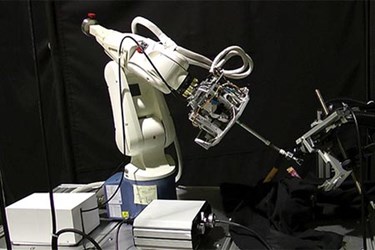NASA-Inspired Robotics For Pediatric Surgery
By Chuck Seegert, Ph.D.

Space robots have been a part of science fiction for several decades, providing entertainment to children for generations. For a newly developed surgical device, however, inspiration from NASA and the International Space Station promises to help children in another way.
Minimally invasive surgery (MIS) reduces trauma associated with operations by allowing for much smaller incisions than were previously possible. If your incisions are smaller, then recovery time decreases as well, which is an important advantage.
To enable small incisions, however, there is an increased need for dexterity when operating. This challenge is even more apparent when operating on pediatric patients, who have a smaller anatomy and different tissue properties.
To meet these unique challenges, Macdonald, Dettwiler, and Associates Ltd. (MDA) partnered with the Hospital for Sick Children (SickKids) Centre for Image-Guided Innovation & Therapeutic Intervention (CIGITI) in Toronto, Canada. MDA is the same company that built the robotic arms for the International Space Station, and according to a recent press release from NASA, the outcome of their collaboration is called KidsArm.
KidsArm is a robot that assists surgeons in pediatric MIS using an advanced imaging and control system. The precision of the system is demonstrated by the delicate structures that it can be used on.
"Our tests indicate we can operate on tiny structures such as blood vessels without damaging them," said Thomas Looi, the project director for one of the partners that developed KidsArm at the CIGITI, in the press release.
According to a research paper published in IEEE Xplore, KidsArm was designed to be an automated anastomosis suture device, or a robot that can reattach tubular structures that have been cut by a scalpel. Procedures could include reattaching the ends of a cut blood vessel or reconnecting portions of a small intestine. The system is designed to be run through a single port, further reducing the incisions when compared to other MIS systems that use two to three. To make this possible, a set of stereo cameras are used to generate a 3D point cloud that guides the robot to the area of interest.
While the team’s goal was to design a system that could perform the surgery by itself, there is still some work to be done.
"The goal of robotic arm is to help doctors perform certain procedures many times faster than if they were only using their hands and with increased accuracy. Some of this would be done autonomously. While we are not quite there yet, KidsArm is able to perform three to five suture points autonomously," Looi said in the press release.
The system is composed of two main elements, the external positioning system and the surgical arm that is inserted into the patient. The team believes that adoption of the KidsArm will lead to more consistent surgical outcomes and earlier intervention than currently possible.
As MIS continues to progress, the goal is to further reduce the surgical trauma to a patient. In a recent article published on Medical Device Online, a new non-invasive camera was introduced for endoscopy procedures.
Image Credit: MDA and CIGITI
